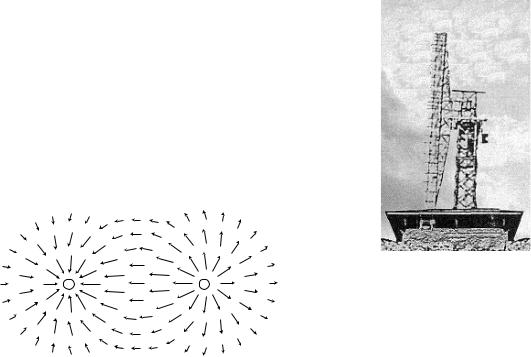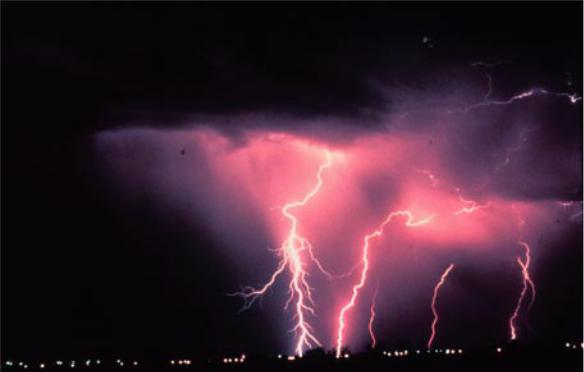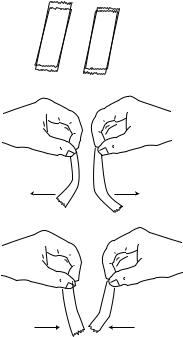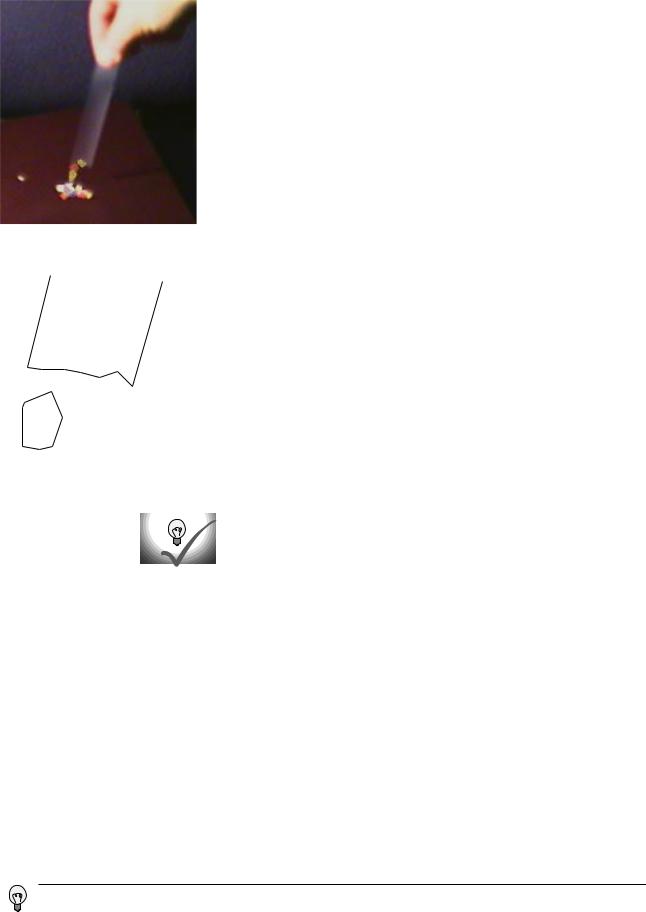
B.Crowell - Electricity and Magnetism, Vol
.4.pdf
5 |
Fields of Force ....... |
109 |
5.1 |
Why Fields? ........................................ |
110 |
5.2 |
The Gravitational Field ....................... |
112 |
5.3 |
The Electric Field ................................ |
114 |
5.4ò Voltage for Nonuniform Fields .......... |
120 |
|
5.5 |
Two or Three Dimensions .................. |
121 |
5.6ò Field of a Continuous Charge |
|
|
|
Distribution ............................... |
123 |
Summary ..................................................... |
119 |
|
Homework Problems .................................. |
120 |
|
– |
+ |
Note: See Simple Nature (www.lightandmatter.com/ area1sn.html) for coverage of the following topics: the Biot-Savart law, LRC circuits, Maxwell's equations.
6 Electromagnetism .127
6.1 The Magnetic Field ............................ |
128 |
6.2Calculating Magnetic Fields
|
and Forces ...................................... |
126 |
6.3 |
Induction ............................................ |
132 |
6.4 |
Electromagnetic Waves ..................... |
136 |
6.5 |
Calculating Energy in Fields .............. |
138 |
6.6* |
Symmetry and Handedness ............. |
142 |
Summary .................................................... |
143 |
Homework Problems .................................. |
144 |
Exercises ..................... |
149 |
Solutions ...................... |
155 |
Glossary ....................... |
157 |
Index ............................. |
159 |
Contents 11
12 Contents
Preface
Who are you? However much you relate your identity to your physical appearance, you know that your personality ultimately resides in the unique arrangement of your brain’s electrical network. Mary Shelley may have conceived of electricity as a mystical life force that could jerk the leg of a dead frog or animate Dr. Frankenstein’s monster, but we now know the truth is both more subtle and more wonderful. Electricity is not the stuff of life but of consciousness.
Evidence is mounting that the universe has produced vast numbers of suitable habitats for life — including, within our own solar system, a watery ancient Mars and the oceans that lie under the icy surface of Jupiter’s moon Europa. But even as we debate claims of fossilized Martian bacteria, a third generation of radio astronomers has found nothing but a wasteland of static in the search for extraterrestrial intelligence.
Is life ubiquitous in the universe but consciousness rare? In terms of geologic time, it took a mere wink of an eye for life to come into being on Earth once conditions were suitable, so there is every reason to believe that it exists elsewhere. Large-brained mammals, however, appear as a virtual afterthought in the record of our biosphere, which remains dominated by single-celled life. Now you begin your study of electricity and magnetism, the phenomena of which your own mind is made. Give some though to this image of awesome loneliness: there may be no other planet in our galaxy of ten billion stars where a collection of electric charges and fields can ponder its own existence.
13
14

1 Electricity and the Atom
Where the telescope ends, the microscope begins. Which of the two has the grander view?
Victor Hugo
His father died during his mother’s pregnancy. Rejected by her as a boy, he was packed off to boarding school when she remarried. He himself never married, but in middle age he formed an intense relationship with a much younger man, a relationship that he terminated when he underwent a psychotic break. Following his early scientific successes, he spent the rest of his professional life mostly in frustration over his inability to unlock the secrets of alchemy.
The man being described is Isaac Newton, but not the triumphant Newton of the standard textbook hagiography. Why dwell on the sad side of his life? To the modern science educator, Newton’s lifelong obsession with alchemy may seem an embarrassment, a distraction from his main achievement, which was the creation the modern science of mechanics. To Newton, however, his alchemical researches were naturally related to his investigations of force and motion. What was radical about Newton’s analysis of motion was its universality: it succeeded in describing both the heavens and the earth with the same equations, whereas previously it had
15

been assumed that the sun, moon, stars, and planets were fundamentally different from earthly objects. But Newton realized that if science was to describe all of nature in a unified way, it was not enough to unite the human scale with the scale of the universe: he would not be satisfied until he fit the microscopic universe into the picture as well.
It should not surprise us that Newton failed. Although he was a firm believer in the existence of atoms, there was no more experimental evidence for their existence than there had been when the ancient Greeks first posited them on purely philosophical grounds. Alchemy labored under a tradition of secrecy and mysticism. Newton had already almost single-handedly transformed the fuzzyheaded field of “natural philosophy” into something we would recognize as the modern science of physics, and it would be unjust to criticize him for failing to change alchemy into modern chemistry as well. The time was not ripe. The microscope was a new invention, and it was cutting-edge science when Newton’s contemporary Hooke discovered that living things were made out of cells.
1.1 The Quest for the Atomic Force
Newton was not the first of the age of reason. He was the last of the magicians...
John Maynard Keynes
Newton’s quest
Nevertheless it will be instructive to pick up Newton’s train of thought and see where it leads us with the benefit of modern hindsight. In uniting the human and cosmic scales of existence, he had reimagined both as stages on which the actors were objects (trees and houses, planets and stars) that interacted through attractions and repulsions. He was already convinced that the objects inhabiting the microworld were atoms, so it remained only to determine what kinds of forces they exerted on each other.
His next insight was no less brilliant for his inability to bring it to fruition. He realized that the many human-scale forces — friction, sticky forces, the normal forces that keep objects from occupying the same space, and so on — must all simply be expressions of a more fundamental force acting between atoms. Tape sticks to paper because the atoms in the tape attract the atoms in the paper. My house doesn’t fall to the center of the earth because its atoms repel the atoms of the dirt under it.
Here he got stuck. It was tempting to think that the atomic force was a form of gravity, which he knew to be universal, fundamental, and mathematically simple. Gravity, however, is always attractive, so how could he use it to explain the existence of both attractive and repulsive atomic forces? The gravitational force between objects of ordinary size is also extremely small, which is why we never notice cars and houses attracting us gravitationally. It would be hard to understand how gravity could be responsible for anything as vigorous as the beating of a heart or the explosion of
16 |
Chapter 1 Electricity and the Atom |

(a) |
gunpowder. Newton went on to write a million words of alchemical notes |
|
filled with speculation about some other force, perhaps a “divine force” or |
|
“vegetative force” that would for example be carried by the sperm to the |
|
egg. |
(b)
Luckily, we now know enough to investigate a different suspect as a candidate for the atomic force: electricity. Electric forces are often observed between objects that have been prepared by rubbing (or other surface interactions), for instance when clothes rub against each other in the dryer. A useful example is shown in figure (a): stick two pieces of tape on a tabletop, and then put two more pieces on top of them. Lift each pair from the table, and then separate them. The two top pieces will then repel each other, (b), as will the two bottom pieces. A bottom piece will attract a top
(c) piece, however, (c). Electrical forces like these are similar in certain ways to gravity, the other force that we already know to be fundamental:
•Electrical forces are universal. Although some substances, such as fur, rubber, and plastic, respond more strongly to electrical preparation than others, all matter participates in electrical forces to some degree. There is no such thing as a “nonelectric” substance. Matter is both inherently gravitational and inherently electrical.
•Experiments show that the electrical force, like the gravitational force, is an inverse square force. That is, the electrical force between two spheres is proportional to 1/r2, where r is the center-to-center distance between them.
Furthermore, electrical forces make more sense than gravity as candidates for the fundamental force between atoms, because we have observed that they can be either attractive or repulsive.
Section 1.1 The Quest for the Atomic Force |
17 |

1.2 Charge, Electricity and Magnetism
Charge
“Charge” is the technical term used to indicate that an object has been prepared so as to participate in electrical forces. This is to be distinguished from the common usage, in which the term is used indiscriminately for anything electrical. For example, although we speak colloquially of “charging” a battery, you may easily verify that a battery has no charge in the technical sense, e.g. it does not exert any electrical force on a piece of tape that has been prepared as described in the previous section.
Two types of charge
We can easily collect reams of data on electrical forces between different substances that have been charged in different ways. We find for example that cat fur prepared by rubbing against rabbit fur will attract glass that has been rubbed on silk. How can we make any sense of all this information? A vast simplification is achieved by noting that there are really only two types of charge. Suppose we pick cat fur rubbed on rabbit fur as a representative of type A, and glass rubbed on silk for type B. We will now find that there is no “type C.” Any object electrified by any method is either A-like, attracting things A attracts and repelling those it repels, or B-like, displaying the same attractions and repulsions as B. The two types, A and B, always display opposite interactions. If A displays an attraction with some charged object, then B is guaranteed to undergo repulsion with it, and vice-versa.
The coulomb
Although there are only two types of charge, each type can come in different amounts. The metric unit of charge is the coulomb (rhymes with “drool on”), defined as follows:
One Coulomb (C) is defined as the amount of charge such that a force of 9.0x109 N occurs between two pointlike objects with charges of 1 C separated by a distance of 1 m.
The notation for an amount of charge is q. The numerical factor in the definition is historical in origin, and is not worth memorizing. The definition is stated for pointlike, i.e. very small, objects, because otherwise different parts of them would be at different distances from each other.
18 |
Chapter 1 Electricity and the Atom |

A model of two types of charged particles
Experiments show that all the methods of rubbing or otherwise charging objects involve two objects, and both of them end up getting charged. If one object acquires a certain amount of one type of charge, then the other ends up with an equal amount of the other type. Various interpretations of this are possible, but the simplest is that the basic building blocks of matter come in two flavors, one with each type of charge. Rubbing objects together results in the transfer of some of these particles from one object to the other. In this model, an object that has not been electrically prepared may actually possesses a great deal of both types of charge, but the amounts are equal and they are distributed in the same way throughout it. Since type A repels anything that type B attracts, and vice versa, the object will make a total force of zero on any other object. The rest of this chapter fleshes out this model and discusses how these mysterious particles can be understood as being internal parts of atoms.
Use of positive and negative signs for charge
Because the two types of charge tend to cancel out each other’s forces, it makes sense to label them using positive and negative signs, and to discuss the total charge of an object. It is entirely arbitrary which type of charge to call negative and which to call positive. Benjamin Franklin decided to describe the one we’ve been calling “A” as negative, but it really doesn’t matter as long as everyone is consistent with everyone else. An object with a total charge of zero (equal amounts of both types) is referred to as electrically neutral.
Self-Check
Criticize the following statement: “There are two types of charge, attractive and repulsive.”
Coulomb’s law
A large body of experimental observations can be summarized as follows:
Coulomb’s law
The magnitude of the force acting between pointlike charged objects at a center-to-center distance r is given by the equation
F |
|
= k |
|
q |
1 |
|
|
|
q 2 |
, |
|
|
|
|
|||||||
|
|
|
|
|
|
|
|
|||
|
|
|
|
r 2 |
|
|||||
|
|
|
|
|
|
|
|
|||
where the constant k equals 9.0x109 N.m2/C2. The force is attractive if the charges are of different signs, and repulsive if they have the same sign.
Clever modern techniques have allowed the 1/r2 form of Coulomb’s law to be tested to incredible accuracy, showing that the exponent is in the range from 1.9999999999999998 to 2.0000000000000002.
Note that Coulomb’s law is closely analogous to Newton’s law of gravity, where the magnitude of the force is Gm 1 m 2 / r 2 , except that there is only one type of mass, not two, and gravitational forces are never repulsive. Because of this close analogy between the two types of forces, we can recycle
Either type can be involved in either an attraction or a repulsion. A positive charge could be involved in either an attraction (with a negative charge) or a repulsion (with another positive), and a negative could participate in either an attraction (with a positive) or a repulsion (with a negative).
Section 1.2 Charge, Electricity and Magnetism |
19 |

(a) A charged piece of tape attracts uncharged pieces of paper from a distance, and they leap up to it.
+ + +
––
++
(b)The paper has zero total charge, but it does have charged particles in it that can move.
a great deal of our knowledge of gravitational forces. For instance, there is an electrical equivalent of the shell theorem: the electrical forces exerted externally by a uniformly charged spherical shell are the same as if all the charge was concentrated at its center, and the forces exerted internally are zero.
Conservation of charge
An even more fundamental reason for using positive and negative signs for electrical charge is that experiments show that charge is conserved according to this definition: in any closed system, the total amount of charge is a constant. This is why we observe that rubbing initially uncharged substances together always has the result that one gains a certain amount of one type of charge, while the other acquires an equal amount of the other type. Conservation of charge seems natural in our model in which matter is made of positive and negative particles. If the charge on each particle is a fixed property of that type of particle, and if the particles themselves can be neither created nor destroyed, then conservation of charge is inevitable.
Electrical forces involving neutral objects
As shown in figure (a), an electrically charged object can attract objects that are uncharged. How is this possible? The key is that even though each piece of paper has a total charge of zero, it has at least some charged particles in it that have some freedom to move. Suppose that the tape is positively charged, (b). Mobile particles in the paper will respond to the tape’s forces, causing one end of the paper to become negatively charged and the other to become positive. The attraction is between the paper and the tape is now stronger than the repulsion, because the negatively charged end is closer to the tape.
Self-Check
What would have happened if the tape was negatively charged?
The path ahead
We have begun to encounter complex electrical behavior that we would never have realized was occurring just from the evidence of our eyes. Unlike the pulleys, blocks, and inclined planes of mechanics, the actors on the stage of electricity and magnetism are invisible phenomena alien to our everyday experience. For this reason, the flavor of the second half of your physics education is dramatically different, focusing much more on experiments and techniques. Even though you will never actually see charge moving through a wire, you can learn to use an ammeter to measure the flow.
Students also tend to get the impression from their first semester of physics that it is a dead science. Not so! We are about to pick up the historical trail that leads directly to the cutting-edge physics research you read about in the newspaper. The atom-smashing experiments that began around 1900, which we will be studying in chapters 1 and 2, were not that different from the ones of the year 2000 — just smaller, simpler, and much cheaper.
It wouldn’t make any difference. The roles of the positive and negative charges in the paper would be reversed, but there would still be a net attraction.
20 |
Chapter 1 Electricity and the Atom |
